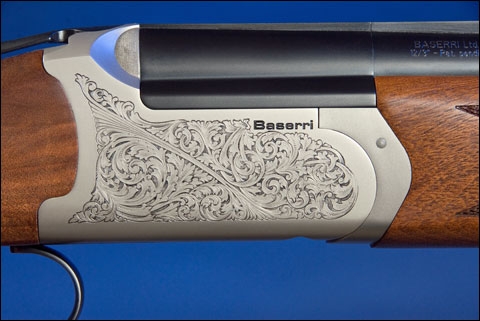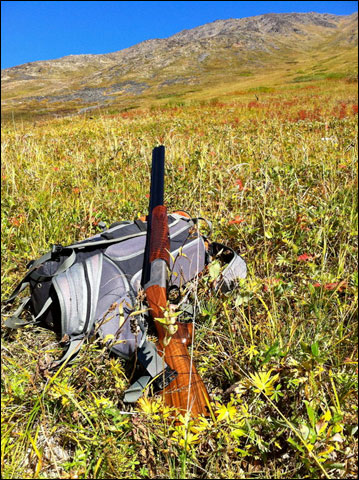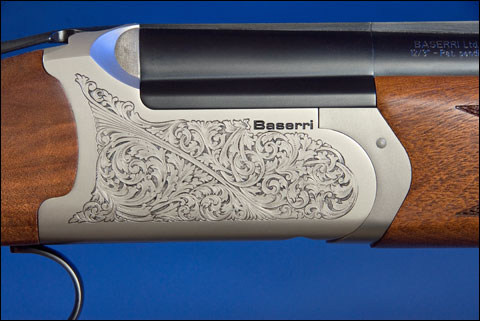Exclusive: First Review of the New Baserri HR Field Shotgun

The Baserri Chronicles Part III: New shotgun companies are a rarity these days, and so when one comes along we’re eager to track its progress. That’s the idea behind our series, the Baserri Chronicles. In this third installment, we shoot the Baserri HR field shotgun.
Many upland hunters consider a round-bodied shotgun the epitome of elegance and handling. The softened edges on the receiver feel natural to the hand, enhancing the instinctive mount for flushing birds. Even gun makers ostensibly believe the round-body is a special breed of field gun, since you’ll find that the action is often adorned with refined engraving.
Think round-bodied shotguns and the number that comes to mind is five grand for a decent specimen. But newcomer Baserri Shotguns continues to upend the price/performance expectations of shooters – this time with its round-body HR over/under field gun priced at only $2,395.
The affordability of the HR captures the spirit of Baserri boxlocks.
The company was started in July 2009 by Texans Alan Thompson and Wayne Rodrigue, who sought to exploit the mid-range market for quality over/under shotguns. Baserris are manufactured by the Italian giant, FABARM. Headquartered in Brescia, the gunmaking center of Italy, FABRAM private labels shotguns and rifles for some of the largest brands in the industry.

Manufacturing involves half the challenge of giving birth to a new shotgun company. As FABRAM ramped up production, Mr. Thompson and Mr. Rodigue hop-scotched around the country lining up more than 50 local dealers for their initial two 12-gauge models: the sporter Mari Elite and the Mari HR field gun.
The initial culmination of their efforts is the first major shipment of Baserris arriving in the U.S. now. The Baserri buzz all over the Internet can finally be addressed with the arrival of their modestly priced shotguns stocked alongside Beretta, Browning, Fausti, Caesar Guerini and other stalwarts in the category.
Any upstart shotgun maker who declares war on those industry giants based on price alone can expect to get crushed under a massive distribution footprint and powerful marketing muscle. Mr. Thompson and Mr. Rodigue, fully aware of the perils, worked closely with FABRAM on engineering a new barrel design that they anticipate will draw shooters to Baserris.
Baserri’s patented Tribore process implements three drilling passes through the chrome molybdenum steel barrel stock. The unique triple-drilling process eliminates the abrupt constriction of forcing cones. Baserri’s Tribore process progressively tapers the bore from .740 inches to .724 inches. The elongated tapering is designed to deliver lower felt recoil and higher shot velocity.

Moreover, Baserri claims that their Tribore barrels surpassed all others in the U.S. by testing to 1,630 BAR – the equivalent of 23,640 psi (the Sporting Arms and Ammunition Manufacturing Institute established a minimum standard of 11,500 psi for 12-gauge shells in 2¾ and 3-inch lengths).
Although the Tribore method is applied to both the Mari Elite and Mari HR, Baserri outfits the HR with an aluminum receiver that lightens the field gun by some two pounds over the Mari Elite and further distinguishes it from the well-known, over/under rivals.
Baserri’s Mari HR weighs 6.2 pounds. Sure you can buy the slightly lighter Caesar Guerini Tempio Light field gun in 12 gauge, but it starts at $3,325 – or some $900 more than the Mari HR. The Beretta 686 Silver Pigeon I 12 gauge field gun tips the scales at around seven pounds, and is priced a couple of hundred dollars less than the Mari HR. Meanwhile, Browning’s Citori 625 Field weighs a hefty 7 pounds, 14 ounces in the 12-gauge model and cost $2,500. At $1,999 Fausti’s 12-gauge Caledon was the least expensive, but also among the heaviest at 7¼ pounds.
I put the Baserri Mari HR through its paces shooting sporting clays, skeet, 5-stand and wobble trap. The pre-production prototype I shot faithfully represented the final models currently arriving at dealers.
The round-body receiver on the Mari HR featured a satin gray finish – like the Blaser F3 – embellished with a floral scroll. A titanium coating inhibited rust and corrosion. The 28-inch barrels are chambered for 3-inch shells and accommodated five standard extended chokes. (As a footnote, Baserri announced a sweeping agreement with Briley that included four extended chokes, which we can expect to see shortly.) Baserri outfitted the Mari HR with a grade of wood that’s typical for a $2,395 field gun. Likewise, the pistol grip was standard fare. Trigger pull was a lovely and predictable 4.1 pounds.

I used an improved cylinder choke on the number-one bottom barrel and modified choke on top, even in skeet. It was an attempt to simulate upland shooting. Likewise, I shot skeet low gun – emulating the fast crossers that would rise up in the corn and wheat fields.
During skeet, my first impression was that the Mari HR did indeed convey low felt recoil. Blasting away with 1⅛-ounce, #8 loads, I fully expected to get whacked in the face. It never happened. That may be attributed to the Tribore barrels. However, a 14¼-inch length of pull made for a definitive mount with my heavy shooting jacket. With an overall length of 45 inches, drop at comb of 1-5/8 inches and a drop at heel of 2½ inches, the dimensions of the Mari HR enabled me to place the stock firmly against my face and shoulder to curb any potential repercussions from excessive recoil.
The Mari HR also provided one of the best target pictures I’ve experienced. This became readily apparent in shooting wobble trap low gun. The Mari HR let me swiftly establish, and powder, the targets.
I discovered that the quick target acquisition promoted the Churchill method of wingshooting whereby you mount the gun a split second before you’re about to pull the trigger. This was really quite surprising for a $2,395 field gun. Baserri’s Mari HR shoots where you look, requiring virtually no lead on wobble trap – again a basic tenet of Churchill. When thrown a high outgoer on the wobble trap field, I deliberately waited for the target to reach 35-45 yards, where the Mari HR performed commendably.
One of the 5-stand courses I tackled was actually pretty darn challenging. With the exception of one incomer that flew along the perimeter of the tree line, all the other targets were 30-50 yards out and high. There was one high incomer that the gun smashed and another long, fast chandelle that the gun got as it started to drop. In reality, these were shots that you probably wouldn’t have taken had they been birds of the feathered variety. Still, the gun proved controllable on those distant shots when you get antsy to pull the trigger.
Ultimately, I walked away with a very favorable impression of Baserri’s Mari HR. Let’s face it, a field gun priced at $2,395 will never stack up against a $100,000 Holland & Holland. Still, I believe you would hard pressed to find a better value.
Now that dealers are receiving ample inventory, the best way to discover the virtues of the Mari HR is shoot a demo model. I fully expect that you may end up buying one on the spot. That’s exactly what happened with two shooters I know who laid their hands on a demo Baserri.
Noe Roland is a frequent contributor to Shotgun Life. You can reach him at letters@shotgunlife.com.
Previous installments of Shotgun Life’s Baserri Chronicles:
Part I: Briley Backs the New Baserri Shotguns With Warranty Work and Line of Chokes
Part II: Baserri Slated to Introduce a Shotgun Designed by Women, for Women
Useful resources:
The Baserri Chronicles Part III: New shotgun companies are a rarity these days, and so when one comes along we’re eager to track its progress. That’s the idea behind our series, the Baserri Chronicles. In this third installment, we shoot the Baserri HR field shotgun.


Comments